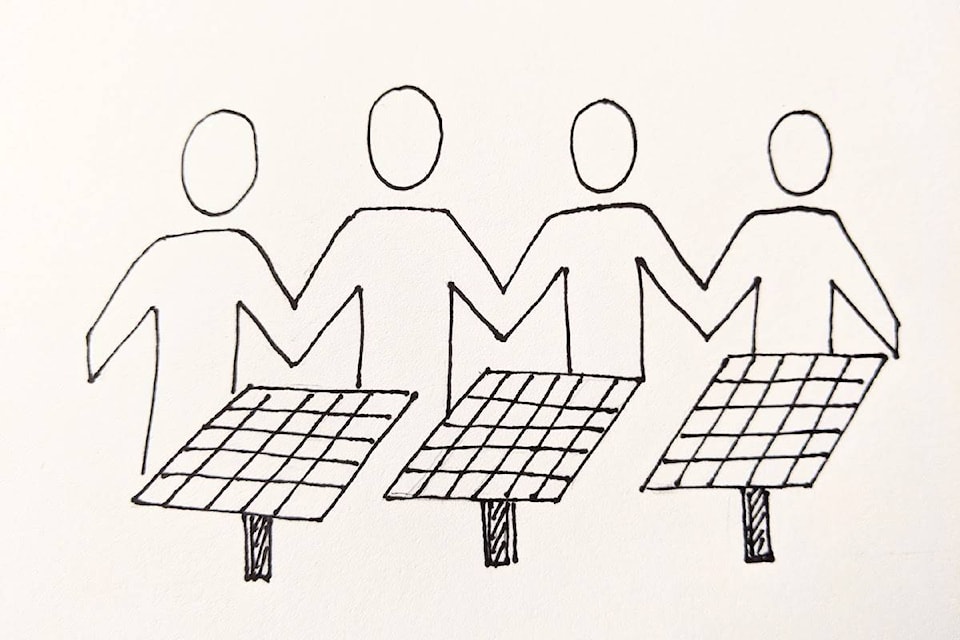Not every roof is a good place to install solar panels. Yours may be shaded by tall trees, or your roof may have only eastern and western exposure. You may live next to a tall building that blocks the noonday sun. Then again, you might be renting. You may intend to stay in your current place for life, but that doesn’t allow you to install solar on the roof.
There is a solution for this, it’s called a community solar garden (CSG). There’s nothing green actually growing (although there’s a movement to plant bee habitat under solar panels) but it was modeled on the idea of a community garden, which provides people with a place to plant and grow vegetables when their living space doesn’t provide a yard.
Community solar gardens provide a place for people to buy clean electricity when they don’t have a suitable rooftop
CSGs belong to investors. However, rather than large investors, CSGs attract individual people who buy-in by contributing money to building the garden. If the investor lives in the same region as the CSG, the amount of their investment determines the kilowatt-hours they own, which are subtracted from their electrical bill (this process is called virtual net metering).
READ MORE: Solar energy technology becoming more efficient
Most CSG are built by frustrated local citizens, determined to get their electricity from a cleaner source, demonstrating their commitment to slowing climate change. Community solar gardens can also be built by a utility, a commercial solar company, or a municipality. The City of Nelson brought the first CSG in Canada online in 2017. Their investors include high schools, churches, renters and business owners. Other CSG have grandparents who have bought shares as presents for their grandchildren. (The solar array in Summerland is not community solar — it will belong to the city utility and is funded by a six million dollar federal grant.)
The state of Minnesota is thought to have the best of the US programs and has seen rapid expansion of CSGs. While half the subscribers are average citizens covering residential electricity needs, the largest amount of energy is purchased by schools, hospitals, local governments, and businesses. Xcel, the largest utility, is unhappy with the legislated plan. Normally utilities buy electricity at wholesale rate (or make it themselves for less) and resell it at a higher retail rate. Most CSG lower your electric bill at the retail rate, rather than the wholesale rate. This leaves Xcel feeling that they are forced to buy high priced electricity from small suppliers, which lowers their profit. They like to point out that lowering overall profit drives up costs for every bill payer, 95% of which do not have a share in a CSG. (Penticton’s net metering plan creates the same effect). I would be more sympathetic with utilities if they planned ahead, building efficient large scale solar plants, and allowed customers to opt-in to solar energy. The slow pace and lack of leadership from utilities have created a market ripe for CSG.
Community solar has both advantages and disadvantages. Rooftop solar always has a choice to make: do we replace the roof now, or will we pull the solar panels off later to replace the roof? Community solar is nearly always a ground installation, skipping the roof problem. Solar panels also make less electricity as they heat up, so ground installations are intrinsically cooler. Finally, because community solar is a bulk purchase it should be cheaper than putting the same kilowatts on separate houses.
READ MORE: Salmon Arm public buildings to be focus of solar energy study
Disadvantages to community solar include forming the legal framework (for profit, nonprofit, municipality) which tracks who owns shares and negotiating with land restrictions for the location of the solar panels and with the utility to set up virtual net metering. CSGs are not the most efficient way to tackle global warming. The larger the installation the lower the cost per kilowatt. In an ideal world every electric utility should be constructing utility scale solar in sizes of 20 MW or more, rather than 5 MW or less. But if you live in a location where you and your neighbors want solar energy and your utility or municipality is dragging its feet, a CSG is just what the doctor ordered.
Interested in organizing a CSG in your neighborhood? Read the UBC guide DEVELOPING A COMMUNITY SOLAR GARDEN
Missed last week’s column?
Dyer: The mess that is plastic recycling
About Kristy Dyer:
Kristy Dyer has a background in art and physics and consulted for Silicon Valley clean energy firms before moving (happily!) to sunny Penticton. Comments to Kristy.Dyer+BP@gmail.com
